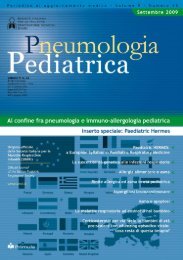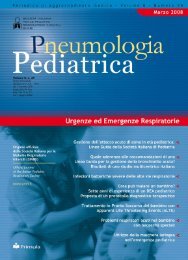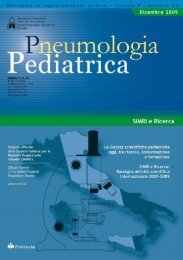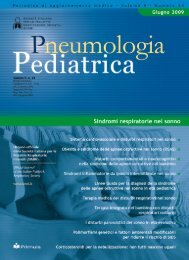Rivista Trimestrale - Primula Multimedia
Rivista Trimestrale - Primula Multimedia
Rivista Trimestrale - Primula Multimedia
You also want an ePaper? Increase the reach of your titles
YUMPU automatically turns print PDFs into web optimized ePapers that Google loves.
10<br />
Maschietto, et al.<br />
polmonare hanno indotto all’utilizzo di terapie<br />
mirate, tra cui gli antagonisti del recettore dell’endotelina<br />
e gli inibitori delle fosfodiesterasi di tipo 5,<br />
la prostaciclina e suoi analoghi anche nei soggetti<br />
con sindrome di Eisenmenger. I miglioramenti in<br />
termini di capacità di esercizio, classe funzionale e<br />
situazione emodinamica senza una compromissione<br />
della saturazione d’ossigeno con l’impiego di<br />
Bibliografia<br />
1. Wood P. The Eisenmenger syndrome or pulmonary<br />
hypertension with reversed central shunt. Br<br />
Med J 1958; 2: 755-762.<br />
2. Eisenmenger V. Die angeborenen Defecte der<br />
Kammerssheidewand des Herzens. Z Klin Med<br />
1897; 32 (suppl 1): 1-28.<br />
3. Granton JT, Rabinovitch M. Pulmonary arterial<br />
hypertension in congenital heart disease. Cardiol<br />
Clin 2002; 20: 441-457.<br />
4. Kidd SA, Lancaster PA, McCredie RM. The incidence<br />
of congenital heart defects in the first year of<br />
life. J Paediatr Child Health 1993; 29: 344-349.<br />
5. Kidd L, Driscoll DJ, Gersony WM, et al. Second<br />
natural history study of congenital heart defects.<br />
Results of treatment of patients with ventricular septal<br />
defects. Circulation 1993; 87 (suppl 2): 138-151.<br />
6. Steele PM, FusterV, Cohen M, et al. Isolated atrial<br />
septal defect with pulmonary vascular obstructive<br />
disease long-term follow-up and prediction of outcome<br />
after surgical correction. Circulation 1987; 76:<br />
1037-1042.<br />
7. Neumayer U, Stone S, Somerville J. Small ventricular<br />
septal defects in adults. Eur Heart J 1998;<br />
19: 1573-1582.<br />
tali terapie hanno messo in discussione il dogma<br />
che la sindrome di Eisenmenger sia una situazione<br />
stabile non passibile di trattamento alcuno.Tuttavia<br />
sono necessari ulteriori ricerche per stabilire se<br />
siano in grado di far regredire il rimodellamento<br />
vascolare e per determinare l’eventuale efficacia di<br />
regimi terapeutici combinati e l’utilità di un trattamento<br />
farmacologico precoce.<br />
8. McLaughlin VV, Archer SL, Badesch DB, et al.<br />
American College of Cardiology Foundation Task<br />
Force on Expert Consensus Documents; American<br />
Heart Association; American College of Chest<br />
Physicians; American Thoracic Society, Inc;<br />
Pulmonary Hypertension Association. ACCF/AHA<br />
2009 expert consensus document on pulmonary<br />
hypertension a report of the American College of<br />
Cardiology Foundation Task Force on Expert<br />
Consensus Documents and the American Heart<br />
Association developed in collaboration with the<br />
American College of Chest Physicians; American<br />
Thoracic Society, Inc.; and the Pulmonary<br />
Hypertension Association. J Am Coll Cardiol 2009;<br />
53: 1573-1619.<br />
9. Simonneau G, Galiè N, Rubin LJ, et al. Clinical<br />
classification of pulmonary hypertension. J Am<br />
Coll Cardiol 2004; 43 (12 Suppl S): S5-S12.<br />
Review.<br />
10. Simonneau G, Robbins IM, Beghetti M, et al.<br />
Updated clinical classification of pulmonary hypertension.<br />
J Am Coll Cardiol 2009; 54 (1 Suppl): S43-<br />
S54. Review.<br />
11. Stewart S. Pulmonary Arterial Hypertension. A<br />
Pocketbook Guide. London:Taylor & Francis, 2005.<br />
BIBLIOGRAFIA







